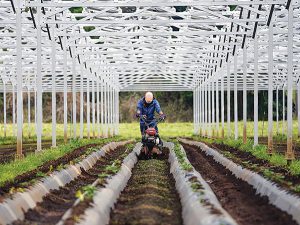In rural America, the shoulder-high corn is increasingly competing with a new cash crop: solar power. Acres of solar panels shine brightly in fields along interstates and rural byways, signaling a change in how America’s farming country generates income. The need for a happy marriage between these old and new industries has inspired a burst of innovation and a new word to describe the combination: Agrivoltaics.
The Inflation Reduction Act includes billions of dollars in renewable energy funds that will accelerate the adoption of solar and other renewables. Some of the new solar panels will land on rooftops, but most will be concentrated in large utility-scale arrays that the US Department of Energy claims could eventually cover an area roughly equivalent in size to Massachusetts, Rhode Island and Connecticut.
Solar panels work best in light winds, moderate temperatures and low humidity. Rooftops share some of these characteristics. But nothing maximizes that combination of traits quite so well as cropland. For solar developers keen to get the most from their investments, that makes farm country irresistible.
For farmers, the attraction is mutual. Depending on the location, solar can be one of the most profitable uses of land. Texas farmers can receive as much as $500 an acre, annually, from solar leases, and California’s Central Valley farmers occasionally see as much as $1,000 an acre. That’s easy money compared to the complicated and often uncertain business of farming.
But the potential scale of these new projects has rattled some agricultural communities, where opposition is growing and threatening the effort to decarbonize the US power supply.
Critics are focusing on the drawbacks of converting farmland to solar generation. Panels are typically placed 18 to 36 inches off the ground, blocking access to the soil. Some dislike the aesthetics and fear that vast solar arrays will change the rural character of their communities.
Meanwhile, false, social media-driven conspiracies about the alleged negative health impacts of the installations are growing in influence.
Right or wrong, rising opposition to solar in rural America is putting climate progress at risk, said James McCall, a researcher at the Energy Department’s National Renewable Energy Laboratory, in a call from Denver. “We need to find a solution that’s a middle ground,” he said.
Brad Heins, professor of animal science at the University of Minnesota, is working on just such a compromise. He’s a leading researcher in agrivoltaics, a growing set of technologies and methods designed to exploit synergies between energy production and agriculture. “We harvest the sun twice,” Heins explains as he unlocks a gate to a large cattle pasture in west-central Minnesota, near the border of North and South Dakota.
The sun’s energy feeds grazing fodder and crops side-by-side with solar panels. “For farmers, it’s a two-income stream,” Heins said. That might mean planting crops that thrive in the shade cast by the panels. Or, in Heins case, it can mean cooling cows in the panels’ shade rather than resorting to expensive fans in a barn.
Heins and his colleagues are at the cutting edge of this new field, but they aren’t alone. There are hundreds of agrivoltaics projects underway in the US. Some work better than others, and some may wind up not working at all. But the best will lead to a greener and more profitable rural America that embraces renewable energy as an asset.
The idea that shade cast by solar panels might boost farm productivity dates to the early 1980s. Japan, a country long obsessed with its limited land and energy reserves, was among the first to explore the concept.
 The Gulf Time Newspaper One of the finest business newspapers in the UAE brought to you by our professional writers and editors.
The Gulf Time Newspaper One of the finest business newspapers in the UAE brought to you by our professional writers and editors.
